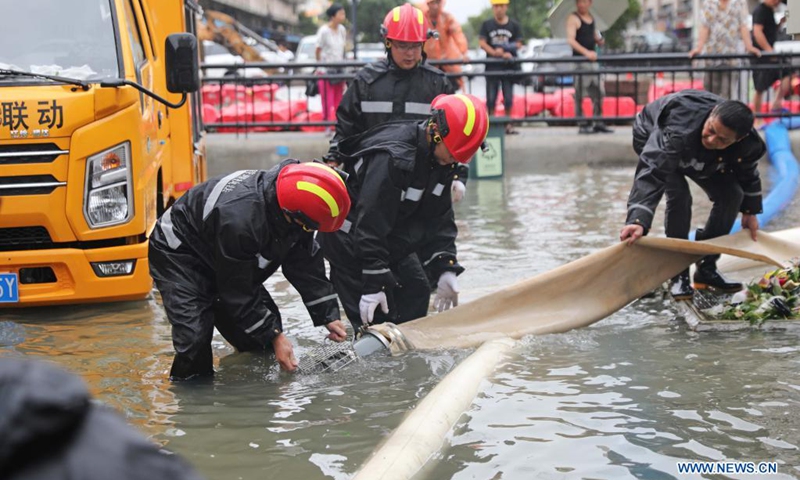Typhoon In-Fa made its second landfall on the coast of Pinghua, East China’s Zhejiang Province on Monday and is expected to move northward. East China’s Zhejiang and Shanghai have been hit by strong winds, rain and storm tides, and coastal areas of Jiangsu and Shandong provinces, North China’s Hebei Province, Tianjin Municipality and Northeast China’s Liaoning Province may also be hit, the National Marine Environmental Center said.
Enough water to fill about 37 West Lakes poured into Yuyao, Zhejiang over the past three days as In-Fa made landfall twice along the coast of Pinghu at about 9:50 am, packing winds of up to 28 meters per second near its center.
According to Zhejiang provincial meteorological station, the cumulative rainfall at Dingjiafan station in Yuyao reached 951 millimeters from 8 am on Thursday to 6 am on Monday breaking the rainfall record for a typhoon landing at a single station in Zhejiang.
Cities are well-prepared for the country’s strongest typhoon in 2021 after lessons learned from the flood disaster in Central China’s Henan Province, where the death toll has risen to 69. The rain was induced by Typhoon In-Fa, experts said.
The Ningbo Lishe International Airport issued an emergency announcement on Monday morning saying that all flights would be canceled on Monday.
Zhejiang has sent rescue teams to transfer residents from risky areas to emergency shelters after it upgraded the typhoon emergency response to Level I. As of Sunday night, more than 1.65 million residents had been transferred.
A resident in Yuyao, who requested anonymity, told the Global Times on Monday that he and his relatives had been transferred to an emergency shelter, and he found that several urban roads were flooded with about 30 centimeters of water. Rescuers are carrying out drainage tasks in the afternoon, the person said.
The National Development and Reform Commission published on Monday an emergency notice on the protection of important urban infrastructure facilities. The notice told local authorities to immediately activate the highest level of response in case of extreme weather and other unusual conditions.
Under the highest level of response, schools, work and transportation in risky areas should be suspended. In tunnels, culverts and other areas vulnerable to flooding, timely alerts and road closures should be taken to evacuate the public in an orderly manner, in order to protect people’s lives and property.
Many railway and subway lines in East China were suspended, and operations will be resumed after the situation improves.
As of 6 pm on Monday, six airports in six cities including Hangzhou, Wenzhou, and Zhoushan in Zhejiang had resumed all or part of their flights.
While Zhejiang authorities escalated their warnings about the influence of the typhoon on the province, Shanghai, which is near the landfall of the typhoon, lowered its warning levels.
The Shanghai Meteorological Bureau lowered its storm warning to blue around 11 am on Monday, saying the heavy precipitation clouds had weakened. But the authorities predicted that the city would still get about 50 millimeters of cumulative rainfall during a period of six hours in the next 24 hours.
Due to the weakening of the typhoon’s influence, flights gradually resumed at Shanghai’s two airports.
A Shanghai-based resident surnamed Yu told the Global Times on Monday she stocked up on enough food and other necessities for three or four days, as many stores and supermarkets closed. On Monday afternoon, she found many take-out and express services had resumed as the rain abated.
According to an announcement sent to the Global Times on Monday afternoon from the National Marine Environmental Center, Typhoon In-Fa is continuing to move northwest and is expected to turn to the northeast direction on Wednesday with accelerated speed.
As the typhoon moves on, coastal areas in Shandong, Hebei, Tianjin and Liaoning may be influenced and face storm tides.
The center issued a yellow alert of the storm tide to Shanghai and Jiangsu’s Nantong, and a blue alert to Shandong’s Rizhao and Jiangsu’s Lianyungang and Yancheng.
The announcement said that from Monday afternoon to Tuesday afternoon, storm surges of 30-80 centimeters may be seen along the coast from the southern part of the Shandong Peninsula to northern Jiangsu, and 50-130 centimeters along the coast from central Jiangsu to the northern Hangzhou Bay.
The center urged related local authorities to do a good job of defensive preparations.
Rescuers prepare to pump rainwater out of a road at a residential area in Zhoushan, east China’s Zhejiang Province, July 25, 2021. (Photo: Xinhua)




